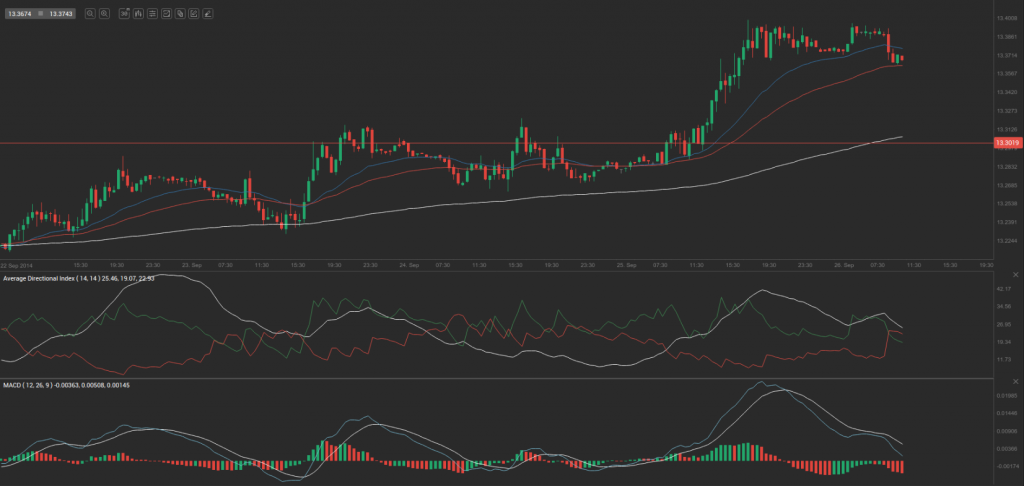Yesterday’s trade saw USD/MXN within the range of 13.2690-13.4055. The pair closed at 13.3868, gaining 0.81% on a daily basis.
At 8:00 GMT today USD/MXN was down 0.10% for the day to trade at 13.3732. The pair touched a daily low at 13.3675 at 8:00 GMT.
Fundamental view
United States
Final Gross Domestic Product
The final estimate of the US Gross Domestic Product probably pointed to an annualized rate of growth of 4.6% in the second quarter of the year. The 2nd GDP estimate, reported on August 28th, pointed to a 4.2% growth. The increase in real GDP in Q2 primarily reflected positive contributions from personal consumption expenditures (PCE), private inventory investment, exports, nonresidential fixed investment, state and local government spending, and residential fixed investment. Imports, which are a subtraction in the calculation of GDP, rose, according to the Bureau of Economic Analysis. Real personal consumption expenditures rose 2.5% in the second quarter, compared with an increase of 1.2% in Q1. Durable goods increased 14.3%, compared with an increase of 3.2%. Nondurable goods increased 1.9% in the second quarter, after remaining unchanged in the first. Services increased 0.8%, compared with an increase of 1.3% in Q1.
The report on GDP holds a lot of weight for traders, operating in the Foreign Exchange Market. It serves as evidence of growth in a productive economy, or as evidence of contraction in an unproductive one. As a result, currency traders will look for higher rates of growth as a sign that interest rates will follow the same direction. Higher interest rates will attract more investors which in terms will increase demand for the common currency. If an economy is experiencing a robust rate of growth, the benefits will eventually affect the end consumer, because of the increased likelihood of spending. Furthermore, through increased consumer expenditures the economy has the potential to expand even more. In case the final GDP exceeded expectations, this would certainly heighten the appeal of the greenback. The official data is due out at 12:30 GMT.
Reuters/Michigan Confidence
The monthly survey by Thomson Reuters and the University of Michigan may show that consumer confidence in the United States improved in September. The final reading of the corresponding index, which usually comes out two weeks after the preliminary data, probably rose to 84.7 during the current month, while the preliminary figure, reported on September 12th, pointed to 82.5, or the highest level since July 2013.
The survey encompasses about 500 respondents throughout the country. The index is comprised by two major components, a gauge of current conditions and a gauge of expectations. The current conditions index is based on the answers to two standard questions, while the index of expectations is based on three standard questions. All five questions have an equal weight in determining the value of the overall index. The sub-index of current economic conditions dropped to a preliminary reading of 98.5 in September from 99.8 in August (the highest level since July 2007), while the gauge of consumer expectations rose to 75.6 this month from 71.3 in August, according to data by Thomson Reuters/University of Michigan.
In case the gauge of consumer sentiment showed a larger improvement than projected, this would boost demand for the US dollar. The final reading is due out at 13:55 GMT.
Mexico
The deficit on Mexican balance of trade probably shrank to 0.744 billion USD in August from a deficit of 0.980 billion USD in the prior month. Exports climbed at a faster pace than imports, boosted by an increase in auto sales to the United States. Total exports rose at an annualized rate of 4.5% to 33.7 billion USD in July. Oil sales fell 19.4%, while non-oil shipments increased 8.2%.
The trade balance reflects the difference in value between exported and imported goods during the respective period. A positive figure indicates that more goods and services have been exported than imported. Export demand has a direct link to demand for the national currency and also causes an impact on levels of production. In case the deficit on Mexico’s trade balance contracted more than expected, this would provide support to the peso. Insituto Nacional de Estadistica Y Geografia is to release the official trade data at 13:00 GMT.
Technical view
According to Binary Tribune’s daily analysis, the central pivot point for the pair is at 13.3538. In case USD/MXN manages to breach the first resistance level at 13.4385, it will probably continue up to test 13.4903. In case the second key resistance is broken, the pair will probably attempt to advance to 13.5750.
If USD/MXN manages to breach the first key support at 13.3019, it will probably continue to slide and test 13.2173. With this second key support broken, the movement to the downside will probably continue to 13.1655.
The mid-Pivot levels for today are as follows: M1 – 13.1914, M2 – 13.2597, M3 – 13.3279, M4 – 13.3962, M5 – 13.4644, M6 – 13.5327.
In weekly terms, the central pivot point is at 13.2041. The three key resistance levels are as follows: R1 – 13.2858, R2 – 13.3607, R3 – 13.4424. The three key support levels are: S1 – 13.1292, S2 – 13.0475, S3 – 12.9726.
USD/MXN has reached highs unseen since early February. Do you think the up move will continue?
Share your opinion with us in the comments section below.






